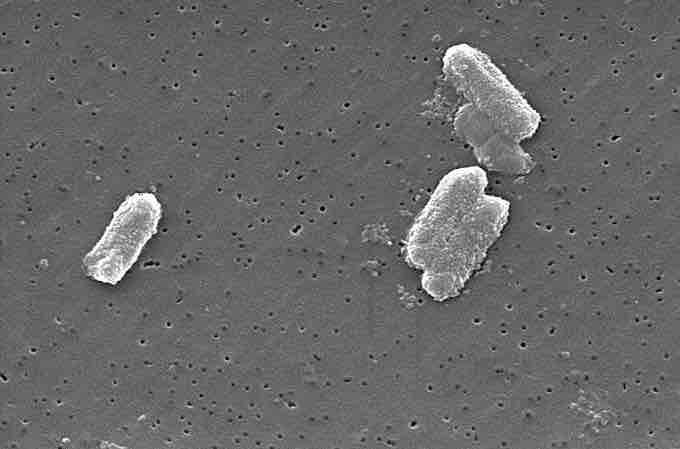Nineteen viral families are currently recognized that infect bacteria and archaea. Of these, only two families have RNA genomes and only five are enveloped. Of the viral families with DNA genomes, only two have single-stranded genomes.
Inoviridae
The Inoviridae are a family of filamentous bacteriophages. The name of the family is derived from the Greek nos, meaning "muscle. "
Taxonomy
There are two genera in this family: Inovirus and Plectrovirus. These genera differ in their host range: Plectovirii infect hosts of the class Mollicutes, while Inovirii infect species of the Enterobacteriaceae , Pseudomonadaceae, Spirillaceae, Xanthomonadaceae, Clostridium, and Propionibacterium classes.

Citrobacter freundii
Citrobacter freundii, one member of the family Enterobacteriaceae. The genus Inovirus infect species of Enterobacteriaceae.
Physical and Genomic Properties
Inoviridae are non-enveloped, rod-shaped, and filamentous. The capsid has a helical symmetry, and in general has a length of 85-280 nm or 760-1950 nm and a width of 10-16 nm or 6-8 nm, respectively. These morphological differences depend on the species.
The genomes are non-segmented, circular, positive-sense, single-stranded DNA, 4.4-8.5 kilobases in length. They encode 4 to 11 proteins. Replication of the genome occurs via a dsDNA intermediate and the rolling circle mechanism. Gene transcription is by the host's cellular machinery, as each gene has a specific promoter.
Life Cycle
There are six steps in the life cycle of Inoviridae:
- Adsorbion to the host via specific receptor(s)
- Movement of the viral DNA into the host cell
- Conversion of the single-strand form to a double-stranded intermediate
- Replication of the viral genome
- Synthesis of the new virions
- Release of the new virions from the host
Action in Host
Conversion from single-stranded to double-stranded form is carried out by the host's own DNA polymerase. The host's RNA polymerase binds to the viral genome and syntheses RNA. Some of this RNA is translated and the remainder is used to initiate DNA replication.
Virion release may involve host lysis, but alternatively productive infection may occur by budding from the host membrane. This pattern is typically seen in the Plectivirus genus. A number of exceptions to this life cycle are known. Lysogenic species, which encode integrases, exist within this family.
Microviridae
The Microviridae are a family of bacteriophages with a single-stranded DNA genome. The name of this family is derived from the Greek micro, meaning "small. " This refers to the size of their genomes, which are among the smallest of the DNA viruses.
Taxonomy
This family is divided into two subfamilies, Gokushovirinae (derived from the Japanese for "very small") and Microvirinae. These groups differ in their hosts, genome structure, and virion composition.
Gokushoviruses are currently known to infect only obligate intra-cellular parasites. These species are members of the genera Bdellovibrio, Chlamydia, and Spiroplasma. Subfamily Microvirinae are all of the genus Microvirus. All seven such members infect Enterobacteria.
Physical and Genomic Properties
Members of the subfamily Gokushovirus have only two structural proteins: capsid proteins F (Virus Protein 1) and DNA pilot protein H (Virus Protein 2) and do not use scaffolding proteins. They also possess 'mushroom-like' protrusions positioned at the three-fold axes of symmetry of their icosahedral capsids. These are formed by large insertion loops within the protein F of gokushoviruses and are absent in the microviruses. They lack both the external scaffolding protein D and the major spike protein G of the species in the genus Microvirus. The genomes of this group tend to be smaller, about 4.5 kb in length. This subfamily includes the genera Bdellomicrovirus, Chlamydiamicrovirus, and Spiromicrovirus.
Microviridae are non-enveloped and round with an icosahedral symmetry. They have a diameter between 25-27 nanometers and lack tails. Each virion has 60 copies each of the F, G, and J proteins and 12 copies of the H protein. Viruses in this family replicate their genomes via a rolling circle mechanism and encode dedicated RCR initiation proteins. Although the majority of species in this family have lytic life cycles, a few may have temperate life cycles.
Life Cycle
There are a number of steps in the life cycle:
- Adsorbion to the host via specific receptor(s)
- Movement of the viral DNA into the host cell
- Conversion of the single-strand form to a double-stranded intermediate, known as the replicative form I
- Transcription of early genes
- Replication of the viral genome
- Late genes are now transcribed by the host's RNA polymerase
- Synthesis of the new virions
- Maturation of the virions in the host cytoplasm
- Release from the host
Action in Host
Cell lysis is mediated by the phiX174-encoded protein E, which inhibits the peptidoglycan synthesis, leading to the eventual bursting of the infected cell.